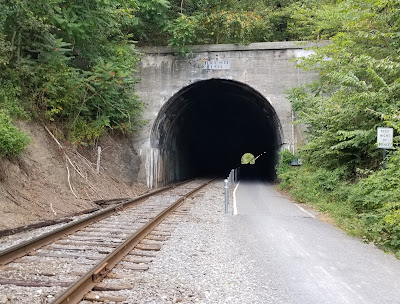So long, Frank Lloyd Wright
I can't believe your song is gone so soon
I barely learned the tune
Several years, the staff of Smithsonian magazine published an article titled “28 Places to See Before You Die.”
The sites on their list include both manmade structures (the Pyramids of Giza, the Parthenon, the Great Wall of China, the Taj Mahal) and natural wonders (Mount Kilimanjaro, the Amazon rain forest, the Great Barrier Reef, the Iguazu Falls).
There’s no way I’ll ever cross most of those sites off my personal “life list” – I’ve never been to Antarctica, Easter Island, the Serengeti desert, or the Yangtze River, and there’s almost zero chance that I ever will visit those places.
In fact, the only place on the list that I had seen before last week was the Grand Canyon.
 |
| Fallingwater |
At first blush, Fallingwater isn’t in the same league as places like Pompeii and Angkor Wat and Machu Picchu. After all, it’s just a house – and a relatively small house at that.
* * * * *
When you tour Fallingwater, you’re struck by the innumerable details that demonstrate Frank Lloyd Wright’s genius. But the whole of Fallingwater is much greater than the sum of its individual parts.
By definition, buildings demarcate the indoors from the outdoors. But even when you are indoors at Fallingwater, you somehow are outdoors as well.
One way Wright accomplished this was to forbid curtains, blinds, or other window coverings.
Another essential element of Fallingwater are the terraces that accompany each of the house’s rooms.
The windows demand that you look outside, while the terraces demand that you go outside.
 |
| My bike tour group prepares to enter Fallingwater |
Click here to learn more about Fallingwater.
* * * * *
A tour of Fallingwater was included in the three-day group biking tour I took part in last week.
At first, I wondered why we were spending the morning walking through Wright’s house instead of riding our bikes. After all, we had a lot of ground to cover on day two of that trip, and our visit to Fallingwater meant that it would be after noon before we hit the trail.
On day one of our trip, we rode 32 miles before breaking for lunch. But on day two, we had to ride 32 miles after lunch.
 |
| At the Mason-Dixon Line: I'm in PA, they're in MD |
Once we reached the Eastern Continental Divide, it was downhill all the way. We lost almost 1800 feet of elevation over the next 25 miles.
And while a 1.5% downhill grade may not sound like much, it was enough to enable me to average 15 or 16 mph – about 20% faster than my average speed on more level ground the previous day. (I spent much of the afternoon in a gear that I had never used before – I had never taken a ride where I could ride fast enough for long enough to get into that gear.)
* * * * *
The last 116 miles or so of the Great Allegheny Passage (“GAP”) bike trail parallels a working railroad track.
That railroad line and the bike trail share the 914-foot-long Brush Tunnel, which was built in 1911:
Click here to see a video that shows you what it would be like to be in the tunnel when a train passes through it.
 |
* * * * *
I was the first of our group to reach Cumberland, MD, where our second day’s ride ended. I was more motivated than my fellow riders – I had handed one of our guides a cooler full of beer to stick in our luggage trailer that morning, and I couldn’t wait to get my hands on a cold one. (Maybe two.)
After a hearty meal at an old-fashioned Italian restaurant in downtown Cumberland, it was early to bed so we’d be early to rise the next morning for day three of our group bike tour – which I’ll describe in the next 2 or 3 lines.
* * * * *
“So Long, Frank Lloyd Wright” was released in 1970 on Simon & Garfunkel’s Bridge Over Troubled Water album. It’s not much of a song, but there aren’t a lot of songs about Frank Lloyd Wright to choose from.
 |
Click here to listen to “So Long, Frank Lloyd Wright.”
And click on the link below to buy the song from Amazon:



No comments:
Post a Comment